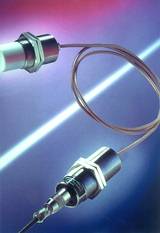Temperature sensor has hot head remote to the electronics
Jan 2000
Sensors & Transducers

A large number of operating procedures often demand process temperatures of up to +200°C. High temperatures mean the end for most electronic devices - not so for Baumer Electric's capacitive CFAH series high temperature sensors.
Available locally from Temperature Controls, these sensors feel really 'at home' when things get hot. Target materials such as liquids, granulates, pastes and similar substances can be detected reliably even at very high ambient temperatures. Since conventional electronic components cannot stand temperatures of 100°C or more over longer periods, this sensor has simply been 'split' into a hot and cold zone. The actual 'hot' sensor head, which can be used at an ambient temperature of -40 to +200°C (optional up to 250°C), is made of chemical-resistant Teflon and stainless steel. It is connected remotely by a high-temperature-proof coaxial cable at a distance of 1 m from the oscillator and decoding electronics, which are installed in an environment of -25 to +75°C. The switching distance of the high temperature sensor is 15 mm and can be adjusted by the potentiometer, which is fitted with the indicating LED on the 'cooler' peripheral device.
Baumer's high temperature sensor CFAH is the ideal substitute for mechanical sensors in a wide range of applications. Due to its high chemical resistance, it can also be used in aggressive environments.
Temperature Controls
(011) 791 6000
Further reading:
Adjustable proximity sensor with five metre range
Sensors & Transducers
The Telco line of photo-electric eyes have the accuracy and reliability you need.
Read more...
Food safety – a matter of weight
Sensors & Transducers
Weighing systems play a key role in ensuring product quality in food production, complying with legal requirements and avoiding product recalls. The Minebea Intec MiNexx portfolio has been specially developed to meet these requirements.
Read more...
Telco sensors in the paper and pulp industry
Sensors & Transducers
The paper and pulp industry poses a major problem for most photoelectric sensors. Telco Sensors has overcome this with its powerful and high-performance photoelectric sensors, ensuring penetration of thick and harsh pollution while guaranteeing reliable detection.
Read more...
Leaders in sensor technology
Sensors & Transducers
A new addition to the Telco Sensors range is the adjustable Proximity sensor, with a range up to 5 metres.
Read more...
Cutting-edge sensor technology
Endress+Hauser South Africa
Sensors & Transducers
The advantage of Endress+Hauser’s Memosens technology is that digitised measured values and sensor information are transmitted via a non-contact connection from the sensor to the cable, and as a digital signal to the transmitter.
Read more...
Miniature inductive sensors
ifm - South Africa
Sensors & Transducers
The inductive IY/IZ type sensors from ifm are used in various industrial areas where space is limited.
Read more...
The expanding role of 3D cameras in industrial quality control
TANDM Technologies
Sensors & Transducers
Across factory floors, warehouses, mines and research centres worldwide, computer vision paired with 3D camera technology is revolutionising quality control.
Read more...
PDS implementation on mines
Sensors & Transducers
Level 9 vehicle intervention for collision avoidance has been mandatory on South African mines since 2022, yet the effective roll-out of proximity detection systems remains slower than expected. This is not due to the technical limitations of integration but to operational readiness on site.
Read more...
Monitoring analogue process values
ifm - South Africa
Sensors & Transducers
Everywhere in industry, electronic sensors are used to detect process values such as temperature, pressure or flow. Process value monitoring often takes place directly in the sensor.
Read more...
Protecting buildings’ embodied carbon with retrofitted systems
Schneider Electric South Africa
Sensors & Transducers
The World Economic Forum has said that around 80% of the buildings in existence will still be around in 2050; it is therefore essential that in order to combat climate change we retrofit them for energy efficiency.
Read more...


